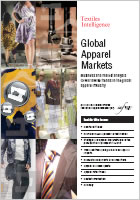Issue
6:
2nd Quarter 2009

Product Overview
Buy this Report now
Buy this Issue now
Subscribe
Download brochure (PDF)
Download price list (PDF)
Price list download
| Please choose your preferred currency:
|
Request sample issue
View list of reports
in other issues
|
Multi Report Package |
We also offer a flexible subscription product,
the Multi Report Package,
which allows you to select your own choice of reports from our full range,
to suit your own budget.
Click here for full details.
|
|
 |
Online clothing retailing: profiles of six companies |

34 pages,
published in Issue 6, 2nd Quarter 2009
Report price:
Euro 600.00;
US$ 785.00
|
Online clothing retailing is a well established sales channel in most developed countries. In 2008 clothing was the fastest growing category of products to be sold online in the UK and the USA. And in China and France it was the largest category in terms of value.
Online retailing offers distinct benefits for shoppers and retailers. From the point of view of the shopper, comparisons of products can be made quickly and easily from the privacy of the shopper?s own home. At the same time, retailers can offer a broader range of products than they are able to do in physical stores. Also, the cost of running an online store is only a fraction of the cost of running a physical shop?especially in terms of rent, rates and staffing. In addition, online shopping provides companies with the opportunity to expand into new markets without needing to invest in physical retail sites.
There are, however, a number of challenges for online clothing retailers to overcome?including the fact that customer loyalty is notoriously hard to retain. Also, online selling results in a much higher level of returns than retailing via physical stores?which is largely due to the fact that online shoppers can not try on the clothing before buying.
Broadly speaking, the strategies of online retailers can be grouped into two categories: multi-channel retailing and online-only retailing. Multi-channel retailing is the most common strategy among large clothing retailers. It allows a firm to use its website as a marketing tool, and enables customers to browse items before trying them on in a physical store. Examples of multi-channel retailers include USA-based Gap, the UK?s Marks and Spencer (M&S) and India-based Future Bazaar?owned by Future Group, the proprietor of Pantaloon Retail.
Online-only retailing involves selling branded clothing exclusively via the Internet. Examples of online-only retailers include UK-based Asos, and Italy-based Yoox. Online-only retailers are characterised by the fact that they offer vast ranges of products?because they are not limited by physical shelf space.
In addition to these strategies, a number of clothing companies have made a foray into online retailing by forming strategic partnerships with established e-commerce companies, such as Bivolino, in order to minimise risk.
- Online clothing retailing: profiles of six companies
-
- Summary
- Introduction
- Selected strategies of online clothing retailers
- Outlook
- Gap
- Asos
- Yoox
- Marks & Spencer (M&S)
- Future Bazaar
- Bivolino
|
 |
